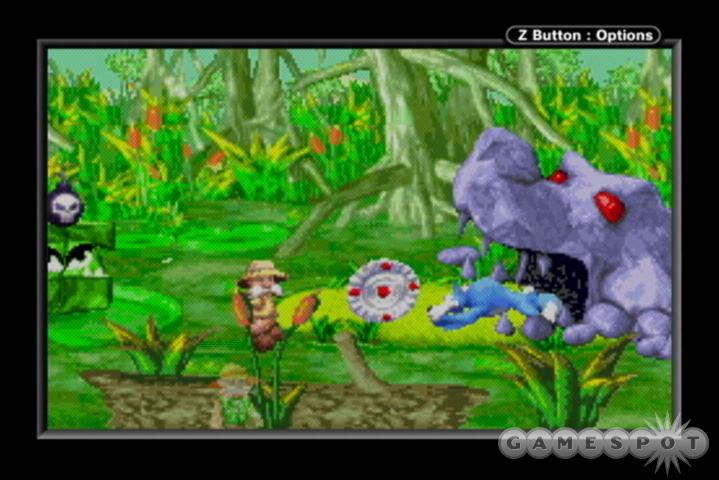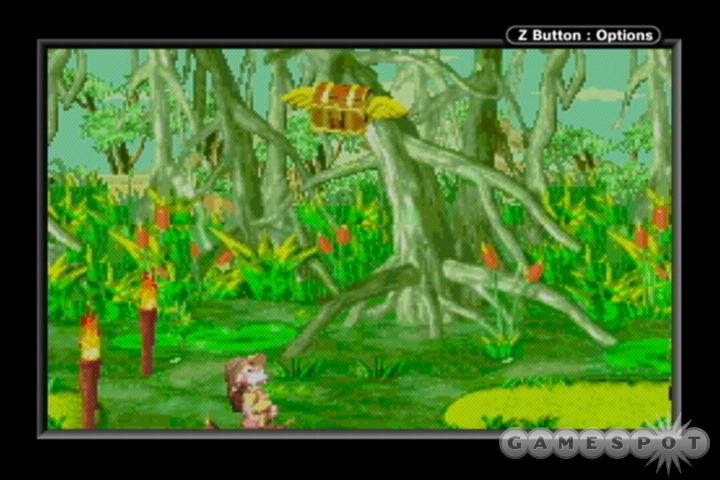Back in 1984, a company called Ultimate released a game called Sabre Wulf for the Sinclair ZX Spectrum computer, a machine that never got much fame in North America, but did pretty well over in Europe. That game was a maze-based adventure that put you in the role of Sabreman, a khaki-clad man on safari, as he searched for four pieces of an amulet that could be used to trap the insidious beast, Sabre Wulf, inside a statue. The game is remembered fondly by most that played it. Now, 20 years later, Ultimate has become Rare, the popular Microsoft-owned developer responsible for games like Banjo-Kazooie and, more recently, Grabbed by the Ghoulies. But the developer is returning to its roots with a 2D platformer with some puzzle elements that picks up where the original Sabre Wulf left off. The resulting game, also called Sabre Wulf, is a fun little game with some interesting gameplay mechanics and some of the Rare charm that you've come to expect.

Sabre Wulf opens with our hero, Sabreman, being roped back into the battle against Sabre Wulf. An evil doctor called Dolittle-Goode has stolen the amulet that kept the wolf locked away inside a statue, and now the two of them are scheming, as evildoers are prone to do. The doctor is setting up laboratories all around the land, and Sabre Wulf is terrifying citizens and stealing loads of treasure all the while. So it's up to you to get that treasure back and bust up the doctor's laboratories, reclaim the eight pieces of the amulet, and once again encase Sabre Wulf in the confines of a statue.
Sabre Wulf has an overworld, which guides you to the game's various levels. Each world has a series of levels, culminating in a laboratory level that, once completed, nets you another eighth of the amulet. There really isn't much story to the game beyond the fact that the citizens of the land need your help to rid the world of the evil doctor and his wolf associate. Instead, the focus is on Sabre Wulf's level-based gameplay.
Aside from running around, Sabreman himself only has one real move--the ability to jump. But you can also enlist the assistance of a collection of various creatures. Creatures can be purchased from a shop, but you'll find plenty to work with in the game's various levels. Basically, each creature that you can summon has a different purpose. Blubba is a sleeping animal with a large stomach that you can bounce off of like a trampoline, getting you to greater heights. Serpent hovers in the air, making a platform you can use to get up to otherwise out-of-reach areas. Boomer explodes, letting you remove obstacles such as blocks or monsters. Sticky is a puddle of goo that sticks enemies to the ground, and so on. The variety of creatures gives you a few options on how you'll handle your business, but since there are only so many ways to get over or through the game's obstacles, you'll find yourself coming back to the same reliable creatures level after level. At the end of the level you'll find Sabre Wulf's cave where he guards his treasure. But getting to the treasure is only half of a level.
After securing the treasure, you'll have to escape with it, which means backtracking to the beginning of the level as quickly as you can. This means you'll have to try to remember the general layout of a level as you make your way through it, but since most levels are reasonably short, this isn't that difficult. Sabre Wulf can outrun Sabreman, but the wolf doesn't turn very well. So you can usually gain some ground on your pursuer just by jumping over his head, waiting for him to turn around, and then jumping back over again to continue running. This makes most of the chases relatively easy.
As you'd expect, the difficulty ramps up as you progress. Getting through the first three worlds is a snap. But once you've collected that third amulet piece, the game starts to get a little tougher. You'll usually have plenty of time to think when you enter a level, giving you ample time to figure out how to get past a series of obstacles. If you're serious about things, you can try to go for the gold by finishing the level within specific time limits. Getting the gold on a level lets you play it in a separate challenge mode, where you're given a time limit and a limited assortment of creatures to use to finish a level. This gives the game some replay value, if you're interested in going through the game's levels again and again.
Sabre Wulf uses the same sort of prerendered sprites that made the Donkey Kong Country series so famous. As a result, the game looks a little blocky and muddy on a Game Boy Player. On an actual GBA, though, the game looks good. Sabreman animates pretty well and the game is bright, with the same sort of charming character design found in other Rare games.

On the sound side of things, the game has some decent music and a handful of speech samples. Most of the in-game speech is handled with unspecific murmuring, similar to the nonsense-speak found in Grabbed by the Ghoulies or The Sims. Sabreman does let out some actual speech from time to time, though. He'll shout something along the lines of "run for it" when you grab the treasure, and he also has a handful of phrases for when you complete a level, like "smashing!" The overtly British accent on Sabreman's voice fits with his bushy-mustached safari persona perfectly.
All in all, Sabre Wulf is fun. It isn't the deepest game in the world, and some may find the gameplay repetitive over time, but the gameplay works well and the game's presentation is passable, too. If you're interested in some light puzzle-solving mixed with even lighter platforming, Sabre Wulf fits the bill.